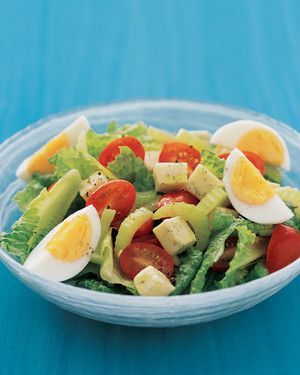The Ultimate Guide for Parents: Crafting the Perfect Salad with Eggs for Kids
Welcome, dear parents, to your go-to guide for integrating the wholesome goodness of eggs into your kiddo’s salad adventures! Preparing a healthy, nutritious, and delicious salad with eggs isn’t just about tossing some greens on a plate; it’s about creating a magical plate of color, texture, and taste that will have your little ones asking for more.
Why Eggs Are Egg-ceptional in Your Child’s Salad
Eggs are little powerhouses of nutrition, making them an excellent addition to your child’s diet. Packed with high-quality protein, vitamins like B12, and minerals such as selenium and choline, eggs can help support your child’s growth and brain development. And guess what? When presented in a fun and creative way, even the pickiest eaters won’t be able to resist!
Getting Started: The Basics of a Good Egg Salad
Before diving into the nitty-gritty, let’s chat about the basics of crafting an egg-cellent salad. You’ll want to ensure your eggs are cooked perfectly — firm yet with a creamy yolk, as hard-boiled eggs are often more kid-friendly and easy to slice or dice. As for the greens, think variety and color; spinach, lettuce, arugula, and kale make excellent bases that are both appealing and packed with nutrients.
How to Boil the Perfect Egg for Salad
Here’s a quick tutorial on boiling the perfect egg for your salad:
- Place your eggs in a single layer in a saucepan and cover with enough water so that there are about 2 inches of water above the eggs.
- Heat on high and bring the water to a boil, then turn off the heat and cover the pan.
- Let the eggs sit in the hot water for 9-12 minutes, depending on the desired firmness of the yolk.
- Transfer eggs to a bowl of ice water to stop the cooking process and make them easier to peel.
- Once cool, tap the eggs gently to crack the shell and peel.
Choosing Your Greens and Veggies
When selecting salad greens, opt for a mix of both mild and slightly peppery leaves to keep things interesting. For veggies, color is key—red bell peppers, cherry tomatoes, cucumbers, and grated carrots not only add a variety of nutrients but also make the salad visually fun for kids.
Adding a Rainbow of Ingredients
Kids love color, and what’s better than eating a rainbow? Encourage your little ones to help choose and prepare a selection of colorful veggies and toppings. This not only makes them more likely to eat their creation, but it also teaches them about the benefits of different foods. Try introducing fruits like strawberries or mandarin oranges for a touch of sweetness, and seeds or chopped nuts for a crunchy texture. Remember to keep the dressing simple and kid-friendly; a light vinaigrette or a creamy yogurt-based dressing usually does the trick!
Assembling the Salad – Let’s Get Creative!
Now, this is where the fun really begins! After preparing your ingredients, let your kids take the lead in assembling their salads. Start with a green base, add sliced hard-boiled eggs, and then let them sprinkle their choice of veggies and toppings. They can create patterns or mix everything for a more spontaneous masterpiece. The act of creating their own meal can be incredibly empowering for children and encourages them to enjoy healthy eating habits.
At the end of the day, teaching your kids about good nutrition doesn’t have to be a chore. By making mealtime fun and interactive, you’re setting the stage for a lifelong appreciation for healthy, balanced eating. Stay tuned as we get deep into crafting creative dressings, uncover the secrets to kid-approved flavor combinations, and explore fun presentation ideas that will make your salad with eggs the star of the mealtime show!
Don’t forget, the key to a successful kid-friendly salad with eggs is to keep it fun, keep it colorful, and keep it interactive. Start your salad adventure today, and watch your little ones turn into veggie-loving, egg-crunching champions of health!

5 Things Parents Should Know When Preparing Salad with Eggs for Kids
1. Nutrient Balance is Key
When creating a salad with eggs for kids, remember that you’re crafting a meal that needs to be as nutritious as it is appealing. Along with the protein and healthy fats from eggs, be sure to include a mix of vegetables for vitamins, minerals, and fiber. Aim for a colorful variety to provide a full range of nutrients.
2. Engage Your Kids in the Process
Allowing children to be part of the prep work not only provides them with an opportunity to learn about the foods they eat, but also increases the likelihood of them enjoying the salad. Have them rinse veggies, peel the hard-boiled eggs, or even mix the dressing. Engagement turns meal prep into a fun activity rather than just another meal.
3. Dressing Can Make or Break the Salad
The right dressing can encourage kids to munch on their greens with gusto. Keep dressings light but flavorful to not overpower the natural tastes of the veggies. Home-made dressings with familiar ingredients like honey, lemon, or yogurt can be healthier and more child-friendly than store-bought varieties.
4. Turn Salad Presentation into an Art
Never underestimate the power of presentation. Arranging a salad in an imaginative way, like creating faces or landscapes, can turn a regular meal into an exciting adventure. Use hard-boiled eggs as focal points, make veggie sun rays, or let your kids build their own edible masterpiece.
5. Safety First!
While involving kids in the kitchen is a fantastic educational opportunity, safety should always come first. Teach them how to handle kitchen tools properly and supervise closely. Use this as an opportunity to instill good kitchen habits and reinforce the importance of handwashing and proper food handling.
Creative Dressings: The Hidden Hero of Every Salad
Dressings add moisture, flavor, and can even be the secret weapon to winning over young salad skeptics. Here are a few quick and easy suggestions:
- Honey Mustard Whisk: Mix equal parts of honey, mustard, and olive oil for a sweet and tangy dressing.
- Creamy Avocado Blend: Combine avocado, Greek yogurt, lime juice, and a pinch of salt in a blender for a creamy, nutrient-packed dressing filled with healthy fats.
- Fruity Vinaigrette Fusion: Whisk together orange juice, olive oil, a bit of honey, and a splash of apple cider vinegar for a light and fruity twist.
Kid-Approved Flavor Combos to Try
Building a savory salad that children will appreciate involves combining flavors they already love. Here are some delicious pairings to consider:
- Classic Combo: Hard-boiled eggs, turkey ham, cheese cubes, and whole grain croutons.
- Sweet and Nutty: Mixed greens, hard-boiled eggs, strawberries, almonds, and a balsamic glaze.
- Garden Delight: Spinach, hard-boiled eggs, cherry tomatoes, cucumbers, and a buttermilk ranch dressing.
Presenting Your Egg Salad with Pizzazz!
Finally, let’s talk about presenting your salad so that it’s nothing short of a showstopper for those discerning little eaters. Use cookie cutters to shape veggies and eggs, or arrange the salad components into a picture or story that resonates with your child’s interests. For instance, an under-the-sea theme with “fish” made from egg slices and “seaweed” from greens can turn dinner time into an exploratory dive. Get those creative juices flowing!
By following these tips, you will not only have made a delectable and healthy salad with eggs but will also have fostered a positive environment for kids to learn about and enjoy nutritious food. The journey from kitchen to dining table becomes an enchanting educational experience that goes beyond just eating. So, let the salad making begin, and may your meals be both merry and bright!
For more great articles please see here. For more information see here
Disclaimer
The articles available via our website provide general information only and we strongly urge readers to exercise caution and conduct their own thorough research and fact-checking. The information presented should not be taken as absolute truth, and, to the maximum extent permitted by law, we will not be held liable for any inaccuracies or errors in the content. It is essential for individuals to independently verify and validate the information before making any decisions or taking any actions based on the articles.




